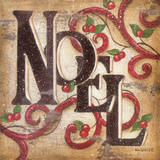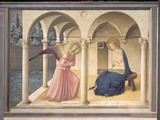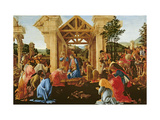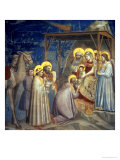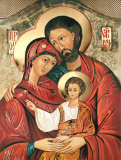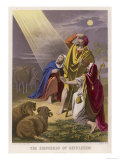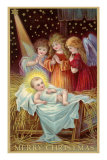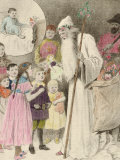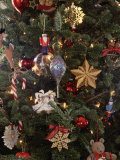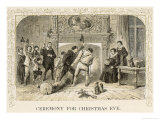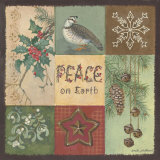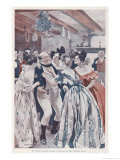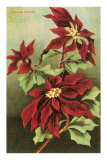|
|
Christmas Posters
for the classroom, home schoolers, and theme decor for offices.
|
social studies > theology > Christianity > CHRISTMAS POSTERS < December Teachable Moments
|
|
Merry Christmas
Froehliche Weihnachten
Buone Feste Natalizie
Natale hilare
Feliz Navidad
Joyeux Noel
Feliz Natal
|
Christmas is the annual Christian holiday celebrating the birth of Jesus, on whose teaching the Christian religion is based. The word Christmas is from the Old English and is a contraction of ‘Christ's mass’. When written as Xmas it is because the X resembles the Greek letter ‘chi’, an abbreviation for Christ.
Celebrating Christmas on December 25 (January 7 for Eastern Orthodox Christianity) is related to the practice of adapting the relatively new Christian faith to already established Roman and Germanic holidays as conversions took place. The pagan holidays marked the winter solstice, the time when the sun, which appeared to be sinking in the sky, reverses and ascends signaling that winter will end and life will return, appropriate symbolism for Jesus.
Many of the traditions associated with modern Christianity such as the Christmas tree, the yule log, and mistletoe are from northern Europe. The wreath, a circular garland with origins in Egyptian, Greek and Roman traditions, is woven with holly, a symbol of goodwill and friendship at Christmas time. The poinsettia was used in colonial Mexico as a Christmas decoration.
|
|
Also see seasonal Observances and Events lists - November | December | January
|
|
|
|
For Christians the Annunciation is the revelation to Mary by the angel Gabriel that she would conceive a child to be born the Son of God. The Feast of Annunciation is usually celebrated March 25, the Incarnation nine months before the feast of the Nativity of Jesus, or Christmas.
• Luke, Chapter 1, verses 26-38.
|
|
|
|
The Magi (word related to magic) were astrologists, very early astronomers, who studied the motion of the stars, and might be considered early pyschologists as they also helped intrepret dreams; they were considered wise by the people who relied on them to prepare for future events.
The Magi's visit is celebrated on Epiphany, a Christian feast celebrated on January 6 (Twelve Days of Christmas). The Jewish festival of lights, Hanukkah, was already an established celebration.
The Magi were following a celestial phenonmena and only learned of the Jewish prophecies about a star appearing that would indicate the arrival of a Messiah, from King Herod.
Giotto di Bondone shows a comet representing the star of Bethlehem. Check with your local planetarium for various astronomical explanations of the star story.
|
|
|
|
The Holy Family, Joseph, Mary & Jesus
The Feast of the Holy Family is a liturgical celebration in the Roman Catholic Church celebrated on the Sunday following Christmas, unless that Sunday is January 1st, in which case it is celebrated on December 30th.
|
|
|
|
|
|
|
The tradition of gift giving to children is personified in Santa Claus whose contemporary image as a large, jolly man in a red suit was created by Clement C. Moore, the author of the famous lines 'Twas the night before Christmas...'
Santa is based on a real life man by the name of Nicholas who was born in Turkey during the 4th century and was known for his devotion to Christianity, his generousity to the poor and love of children. When Nicholas was canonized he became known as Saint Nicholas which evolved into Santa Claus.
FYI ~ The name Nicholas is from the winged Greek goddess of victory, Nike.
Ever heard of The Krampus? - St. Nickolas has a servant - the Krampus - who, according to German legend, would terrorize those who didn't have a pure heart. The parent's hope was that their misbehaving children would be frightened into mending their ways.
Santa Claus putting toys in stocking probably could be traced to the tradition of St. Nicholas putting treats in the wooden shoes of Dutch children. |
|
|
|
|
|
|
Yule is the winter solstice celebration of Germanic culture and the term has become synonymous with Christmas.
|
|
|
|
|
|
|
|
|
|
The red and green poinsettia (Euphorbia pulcherrima) is a shrub plant native to parts of Mexico and Guatemala is a member of the Euphorbiaceae family.
The plant has been associated with Christmas since it was used in 17th century Spanish missions as a decoration to celebrate the birth of Jesus.
The plant was introduced into the US in 1828 by Joel Roberts Poinsett, the first United States Ambassador to Mexico.
• The Legend of the Poinsettia
• more flower posters
|
|
|
| “Yes Virginia, there is a Santa Claus”
Dear Editor,
I am 8 years old. Some of my little friends say that there is no Santa Claus. Papa says "If you see it in the Sun, it is so." Please tell me the truth, is there a Santa Claus?
Virginia,
Your little friends are wrong. They have been affected by the skepticism of a skeptical age. They do not believe except what they see. They think that nothing can be which is not comprehensible by their little minds.
All minds, Virginia, whether they be men's or children's, are little. In this great universe of ours, man is a mere insect, an ant, in his intellect, as compared with the boundless world about him, as measured by the intelligence capable of grasping the whole of truth and knowledge.
Yes, Virginia, there is a Santa Claus. He exists as certainly as love and generosity and devotion exist, and you know that they abound and give to our life its highest beauty and joy.
Alas! How dreary would be the world if there were no Santa Claus! It would be as dreary as if there were no Virginias. There would be no childlike faith then, no poetry, no romance to make tolerable this existence. We should have no enjoyment, except in sense and sight. The eternal light with which childhood fills the world would be extinguished.
Not believe in Santa Claus? You might as well not believe in fairies! You might get your Papa to hire men to watch all the chimneys on Christmas Eve to catch Santa Claus, but even if they did not see Santa Claus coming down, what would that prove?
Nobody sees Santa Claus, but that is no sign that there is no Santa Claus The most real things in the world are those that neither children nor men can see.
Did you ever see fairies dancing on the lawn? Of course not, but that's no proof that they are not there. Nobody can conceive or imagine all the wonders that are unseen and unseeable in the world.
You tear apart the baby's rattle and see what makes the noise inside, but there is a veil covering the unseen world which not the strongest man, or even the united strength of all the strongest men that ever lived, could tear apart. Only faith, fancy, poetry, love, romance, can push aside that curtain and view and picture the supernatural beauty and glory beyond.
Is it all real? Ah, Virginia, in all this world there is nothing else as real and abiding.
No Santa Claus? Thank God he lives and he lives forever. A thousand years from now, maybe 10 times 10,000 years from now, he will continue to make glad the hearts of children.
Written by Francis P. Church in 1897
|
|
|
previous page | top
|
|
I have searched the web for visual, text, and manipulative curriculum support materials - teaching posters, art prints, maps, charts, calendars, books and educational toys featuring famous people, places and events - to help teachers optimize their valuable time and budget.
Browsing the subject areas at NetPosterWorks.com is a learning experience where educators can plan context rich environments while comparing prices, special discounts, framing options and shipping from educational resources.
Thank you for starting your search for inspirational, motivational, and educational posters and learning materials at NetPosterWorks.com. If you need help please contact us.
|
|
|
|


























